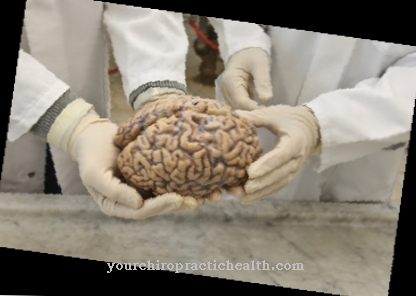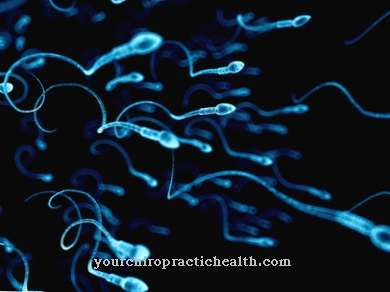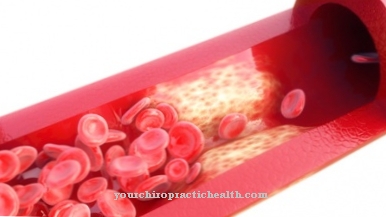As Pressure pulse In physiology, the representation of blood pressure in curve form is called. A distinction must be made between this and the cardiological pressure pulse, which corresponds to a strong bradycardiac pulse with a simultaneous increase in blood pressure and is considered a symptom of increasing intracranial pressure. Increases in intracranial pressure can be associated with inflammation, tumors or cerebral haemorrhage.
What is the pressure pulse?

The pulse is the mechanically rhythmic expansion or contraction of the vascular wall muscles, which is caused by the action of the heart. Sometimes the pulse also means the electronically measurable and palpable expansion of the arteries in certain parts of the body.
The heart sends out pressure waves, which are reflected in the behavior of the individual vessels. The recording of pressure waves or the course of blood pressure during diastole and systole of the heart is called pressure pulse by physiology. This recording is made as a curve display that can clearly record the pressure waves.
Cardiology also speaks of the pressure pulse when the pulse quality is certain. The cardiologist describes such a bradycardic, strong pulse with a simultaneous rise in blood pressure as a pressure pulse. Bradycard in this context means that the patient's heart rate slows down despite the rise in blood pressure. As a pulse quality in cardiology, the pressure pulse is pathophysiologically associated and thus indicates symptomatically to pathological body processes.
Function, effect & goals
The pressure pulse of the physiology corresponds to the graphical recording of the blood pressure course in sys- and diastole of the heart, which corresponds to a curve display. Within the aorta there is a slow blood pressure curve with lower values than in the peripheral vessels. The individual vessels in the human body have different anatomical structures. In the periphery of the body the vessels are somewhat narrower and somewhat less elastic than in the center of the body.
These differences in quality lead to differences in the blood pressure curve between the periphery and the center. The differences are noticeable both quantitatively and qualitatively. In addition, the pressure waves emitted by the heart reflect on branching vessels and sphincter vessels. The reflected pressure waves pull back, so to speak, towards the heart, which is already sending out the next pressure wave. With this newly transmitted wave, the reflected pressure waves add up, so that the newly transmitted wave becomes excessive.
In addition, the newly sent pressure wave from the heart reflects again on branching vessels and sphincter vessels and this reflection creates a weak, two-beat pulse wave, which is also known as a dicrotic pulse wave.
For this reason, the pressure pulse in the sense of the graphic pulse display naturally shows a higher blood pressure amplitude in the peripheral vessels than in the center. The term pulse amplitude relates to the fact that the heart works in two different phases. The first of these is the contraction phase, or expulsion phase, also known as systole. The second phase is the relaxation phase, or diastole, known as the filling or resting phase. For this reason, the heart creates its pressure waves only during the contraction of systole. The difference between the peak systolic pressure and the minimum diastolic pressure is the pulse amplitude, the pulse pressure or the blood pressure amplitude.
Due to the vascular quality in the periphery and center as well as due to the wave reflections, a greater amplitude of the blood pressure is present in the pressure pulse measurement even in a lying position within the legs or feet than within the center. In the vicinity of the heart, the curve of the pressure pulse shows an incision, which is also known as an incision. This incision is due to a small backflow of blood against the aortic valves. The closure of the aortic valve usually eliminates the incision.
Illnesses & ailments
In cardiology, the pressure pulse does not mean the graphic representation with the characteristics described, but a slow and at the same time strong pulse that is accompanied by an increase in blood pressure. In this context, the pressure pulse is a possible symptom of pathological body processes. Pathophysiology knows the cardiological pressure pulse as a symptom of a rapid increase in intracranial pressure. Rapid increases in intracranial pressure are life threatening. When the pressure rises, the brain no longer has enough space and is ultimately pinched or dented. When the vegetative areas of the brain are compressed, death occurs.
Different disease processes can be responsible for a rapid increase in intracranial pressure and the associated pressure pulse. One of them is a rapidly growing tumor. The tumor tissue expands and displaces the nerve tissue of the brain, so that the intracranial pressure increases bit by bit.
An increase in intracranial pressure does not always have to be associated with tumor diseases. Meningitis or other inflammatory processes in the brain tissue can also increase the pressure inside the skull. Microorganisms such as bacteria may be responsible for inflammatory processes in the brain. Autoimmune diseases such as multiple sclerosis can also cause a slight increase in pressure due to inflammatory processes, but this usually does not lead to a life-threatening situation and is typically not accompanied by a pressure pulse.
It is different with brain edema. Above a certain size, such water accumulations in the brain can manifest themselves in a rapid increase in intracranial pressure with a pressure pulse. Cerebral haemorrhage as a result of accidental trauma is life-threatening from a certain extent of the bleeding, as the brain tissue can lose space due to the escaping blood and the pressure in the brain increases.
In addition to the pressure pulse, rising intracranial pressure manifests itself in symptoms such as clouding of consciousness or unconsciousness, as well as nausea and vomiting with severe headaches. The compression of the brain tissue associated with the increase in pressure can also cause deficits in all body processes, such as motor, language or cognitive deficits.

























.jpg)

.jpg)
